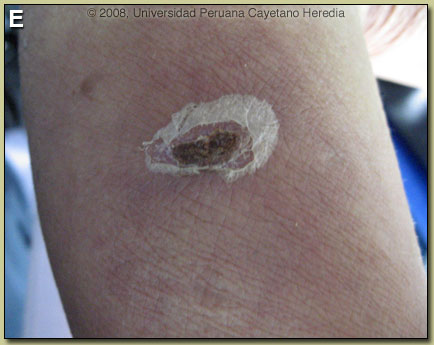| 2008 Case #11 |  |
|
|
We hope you have enjoyed the 2008 series of live cases each week from Peru. The Gorgas Diploma Course runs annually in February and March and we will be in touch at the beginning of next year’s case series. In addition to the 2008 cases on the Gorgas website, cases from previous years are available for full CME credit at no charge at the UAB School of Medicine's Division of Continuing Medical Education. Eduardo Gotuzzo, M.D. and David O. Freedman, M.D. |
| The patient was seen in the Intensive Care Unit of the 400-bed Cayetano Heredia National Hospital. |
|
History: 41 yo male admitted with a 10 day history of difficulty in opening the mouth followed soon after by sweating and painful generalized muscle rigidity. The patient suffered abrasions on the skin after exposure to fireworks 13 days before admission; he noted difficulty in opening his mouth and painful cervical muscle contractions beginning three days after the injury. These symptoms were followed by the onset of periodic episodes of very painful generalized contractions affecting the lower back and the limbs, odynophagia and profuse sweating on the face and chest two days later. No relevant past medical history. No suspicious dietary ingestions, no animal bites, and no exposure to anyone that was ill. Epidemiology: Born in the highlands of Cajamarca but living in Lima for the last 40 years. The patient works selling soft drinks on the street, he does not remember his vaccination history. Physical Examination: Afebrile, BP 130/90, pulse 96, respirations 24. Diaphoretic. Trismus exaggerated during periods of spasm [Image A], very limited mouth opening; paravertebral muscle spasm with constant arching of the back [Image B] was present as were generalized spasmodic muscle contractions [Images C, D]. Sensory examination normal. Laboratory Examination: Hematocrit 44. WBC 13,500. Creatinine 1.4 mg/dl. CPK 417 (elevatated). ALT 51.
|
| Diagnosis: Tetanus, generalized form. |
 Discussion: Generalized tetanus is a purely clinical diagnosis with highly characteristic features and the diagnosis is usually made within a few minutes of arrival at a medical facility. In general, disease begins with trismus or lockjaw, which are spasms of the masseter muscles, although, initial symptoms may occur in other muscle groups. After a variable period the symptoms progress to generalized muscular rigidity, on which is superimposed increasingly severe generalized reflex muscular spasms manifested by the characteristic sardonic smile (risus sardonicus), opisthotonos (arched back), and spasm of respiratory muscles and larynx. In severe cases there are prolonged spasms occurring less than 1 hour apart, and in very severe cases there is autonomic hyperactivity with sweating, fever, tachycardia, salivation, arrhythmias, hyper- or hypo-tension, hyperthermia, etc. Some aspects of generalized disease can be mimicked by hypocalcemic tetany, phenothiazine induced dystonia, epilepsy, rabies, strychnine poisoning, or narcotic withdrawal, but the history of wound [Image E for this patient] (not always elicited), epidemiology, and clinical course of tetanus usually lead to little confusion. Mild localized tetanus in which trismus does not progress to generalized disease with reflex spasms is rare. In the initial phase, the trismus itself has a broader differential diagnosis including dipththeria, partotitis, retropharyngeal abscess, and traumatic injury. Discussion: Generalized tetanus is a purely clinical diagnosis with highly characteristic features and the diagnosis is usually made within a few minutes of arrival at a medical facility. In general, disease begins with trismus or lockjaw, which are spasms of the masseter muscles, although, initial symptoms may occur in other muscle groups. After a variable period the symptoms progress to generalized muscular rigidity, on which is superimposed increasingly severe generalized reflex muscular spasms manifested by the characteristic sardonic smile (risus sardonicus), opisthotonos (arched back), and spasm of respiratory muscles and larynx. In severe cases there are prolonged spasms occurring less than 1 hour apart, and in very severe cases there is autonomic hyperactivity with sweating, fever, tachycardia, salivation, arrhythmias, hyper- or hypo-tension, hyperthermia, etc. Some aspects of generalized disease can be mimicked by hypocalcemic tetany, phenothiazine induced dystonia, epilepsy, rabies, strychnine poisoning, or narcotic withdrawal, but the history of wound [Image E for this patient] (not always elicited), epidemiology, and clinical course of tetanus usually lead to little confusion. Mild localized tetanus in which trismus does not progress to generalized disease with reflex spasms is rare. In the initial phase, the trismus itself has a broader differential diagnosis including dipththeria, partotitis, retropharyngeal abscess, and traumatic injury.
Disease is caused by a toxin, tetanospasmin, released by Clostridium tetani which infect the wound. Spread of toxin is both retrograde through the affected axons as well as via blood to nerve endings in other parts of the body. Masseters are usually affected first due to their short axons. The action is pre-synaptic, irreversible, and blocks inhibitory neurotransmitter action leading to muscle spasm. Poor prognostic indicators include short incubation period (<7 days) from time of the wound to onset of symptoms (4 days here), short period of onset (<48 hours), from onset of symptoms to first reflex spasm (3 days here), and high-risk portal of entry (compound fracture, gynecologic, postoperative, and burns). Management is complex and must be done in a well-equipped Intensive Care Unit (ICU). Non-ICU care is associated with almost universal mortality. General principles are listed here, but detailed written dosing protocols must be available and used for most interventions.
|